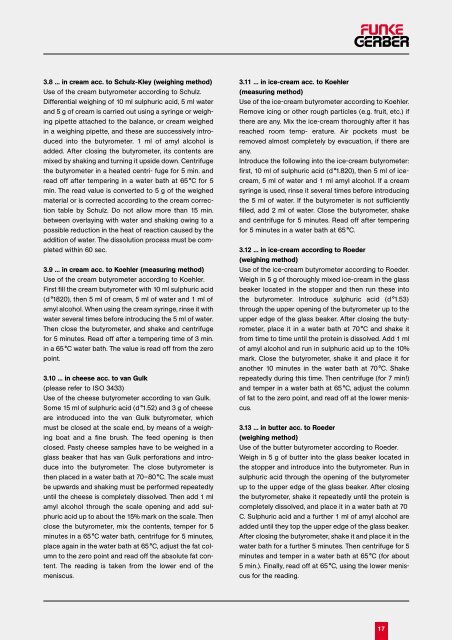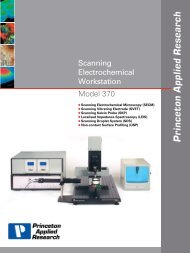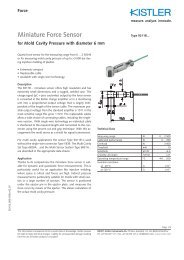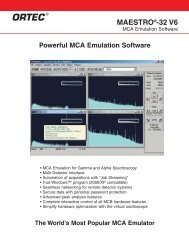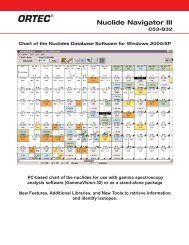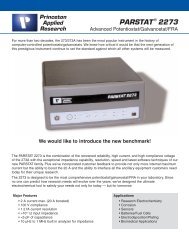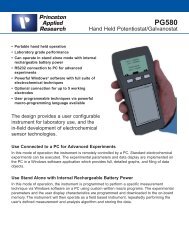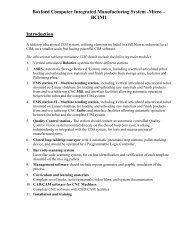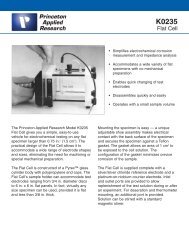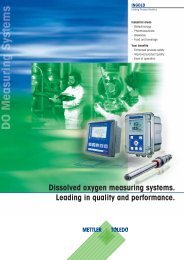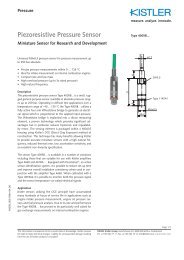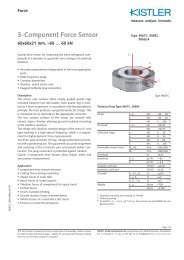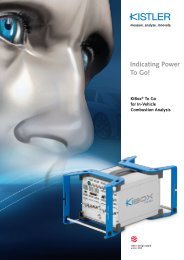Laboratory catalogue
Laboratory catalogue
Laboratory catalogue
Create successful ePaper yourself
Turn your PDF publications into a flip-book with our unique Google optimized e-Paper software.
3.8 ... in cream acc. to Schulz-Kley (weighing method)<br />
Use of the cream butyrometer according to Schulz.<br />
Differential weighing of 10 ml sulphuric acid, 5 ml water<br />
and 5 g of cream is carried out using a syringe or weighing<br />
pipette attached to the balance, or cream weighed<br />
in a weighing pipette, and these are successively introduced<br />
into the butyrometer. 1 ml of amyl alcohol is<br />
added. After closing the butyrometer, its contents are<br />
mixed by shaking and turning it upside down. Centrifuge<br />
the butyrometer in a heated centri- fuge for 5 min. and<br />
read off after tempering in a water bath at 65 °C for 5<br />
min. The read value is converted to 5 g of the weighed<br />
material or is corrected according to the cream correction<br />
table by Schulz. Do not allow more than 15 min.<br />
between overlaying with water and shaking owing to a<br />
possible reduction in the heat of reaction caused by the<br />
addition of water. The dissolution process must be completed<br />
within 60 sec.<br />
3.9 ... in cream acc. to Koehler (measuring method)<br />
Use of the cream butyrometer according to Koehler.<br />
First fill the cream butyrometer with 10 ml sulphuric acid<br />
(d °1820), then 5 ml of cream, 5 ml of water and 1 ml of<br />
amyl alcohol. When using the cream syringe, rinse it with<br />
water several times before introducing the 5 ml of water.<br />
Then close the butyrometer, and shake and centrifuge<br />
for 5 minutes. Read off after a tempering time of 3 min.<br />
in a 65 °C water bath. The value is read off from the zero<br />
point.<br />
3.10 ... in cheese acc. to van Gulk<br />
(please refer to ISO 3433)<br />
Use of the cheese butyrometer according to van Gulk.<br />
Some 15 ml of sulphuric acid (d °1.52) and 3 g of cheese<br />
are introduced into the van Gulk butyrometer, which<br />
must be closed at the scale end, by means of a weighing<br />
boat and a fine brush. The feed opening is then<br />
closed. Pasty cheese samples have to be weighed in a<br />
glass beaker that has van Gulk perforations and introduce<br />
into the butyrometer. The close butyrometer is<br />
then placed in a water bath at 70–80 °C. The scale must<br />
be upwards and shaking must be performed repeatedly<br />
until the cheese is completely dissolved. Then add 1 ml<br />
amyl alcohol through the scale opening and add sulphuric<br />
acid up to about the 15% mark on the scale. Then<br />
close the butyrometer, mix the contents, temper for 5<br />
minutes in a 65 °C water bath, centrifuge for 5 minutes,<br />
place again in the water bath at 65 °C, adjust the fat column<br />
to the zero point and read off the absolute fat content.<br />
The reading is taken from the lower end of the<br />
meniscus.<br />
3.11 ... in ice-cream acc. to Koehler<br />
(measuring method)<br />
Use of the ice-cream butyrometer according to Koehler.<br />
Remove icing or other rough particles (e.g. fruit, etc.) if<br />
there are any. Mix the ice-cream thoroughly after it has<br />
reached room temp- erature. Air pockets must be<br />
removed almost completely by evacuation, if there are<br />
any.<br />
Introduce the following into the ice-cream butyrometer:<br />
first, 10 ml of sulphuric acid (d °1.820), then 5 ml of icecream,<br />
5 ml of water and 1 ml amyl alcohol. If a cream<br />
syringe is used, rinse it several times before introducing<br />
the 5 ml of water. If the butyrometer is not sufficiently<br />
filled, add 2 ml of water. Close the butyrometer, shake<br />
and centrifuge for 5 minutes. Read off after tempering<br />
for 5 minutes in a water bath at 65 °C.<br />
3.12 ... in ice-cream according to Roeder<br />
(weighing method)<br />
Use of the ice-cream butyrometer according to Roeder.<br />
Weigh in 5 g of thoroughly mixed ice-cream in the glass<br />
beaker located in the stopper and then run these into<br />
the butyrometer. Introduce sulphuric acid (d °1.53)<br />
through the upper opening of the butyrometer up to the<br />
upper edge of the glass beaker. After closing the butyrometer,<br />
place it in a water bath at 70 °C and shake it<br />
from time to time until the protein is dissolved. Add 1 ml<br />
of amyl alcohol and run in sulphuric acid up to the 10%<br />
mark. Close the butyrometer, shake it and place it for<br />
another 10 minutes in the water bath at 70 °C. Shake<br />
repeatedly during this time. Then centrifuge (for 7 min!)<br />
and temper in a water bath at 65 °C, adjust the column<br />
of fat to the zero point, and read off at the lower meniscus.<br />
3.13 ... in butter acc. to Roeder<br />
(weighing method)<br />
Use of the butter butyrometer according to Roeder.<br />
Weigh in 5 g of butter into the glass beaker located in<br />
the stopper and introduce into the butyrometer. Run in<br />
sulphuric acid through the opening of the butyrometer<br />
up to the upper edge of the glass beaker. After closing<br />
the butyrometer, shake it repeatedly until the protein is<br />
completely dissolved, and place it in a water bath at 70<br />
C. Sulphuric acid and a further 1 ml of amyl alcohol are<br />
added until they top the upper edge of the glass beaker.<br />
After closing the butyrometer, shake it and place it in the<br />
water bath for a further 5 minutes. Then centrifuge for 5<br />
minutes and temper in a water bath at 65 °C (for about<br />
5 min.). Finally, read off at 65 °C, using the lower meniscus<br />
for the reading.<br />
17


